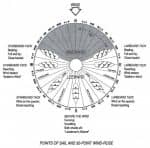Naval Facts
This section gives further information on some of the terms used in naval fiction books.

Today we are used to the White Ensign being flown by all ships of the Royal Navy. However in Nelson's Day a different system was in use.
The Navy was divided into three squadrons Red, White and Blue in order of seniority. Admirals were appointed to these squadrons and therefore their rank and squadron split the seniority into 9 bands with ‘Admiral of the Fleet' forming a tenth senior to all others.
When reading a novel about the Royal Navy in the Napoleonic era you will usually find a reference to the Articles of War. They were read at least once a month, usually when church was rigged on Sunday, and when punishment was inflicted.
The Articles were originally established in the 1650s, amended in 1749 (by an act of Parliament) and again in 1757. It is an amazing document to study, and to note the number and degree of offenses which were punishable by death.
 The size of cannon carried varied dependent on the size of the ship and the larger the cannon the larger the crew needed to haul it's weight up to the port. A cannon firing 24 pound shot would weigh about two and a half tons.
The size of cannon carried varied dependent on the size of the ship and the larger the cannon the larger the crew needed to haul it's weight up to the port. A cannon firing 24 pound shot would weigh about two and a half tons.
In the magazines, the gunner and his mates would have the required amount of gunpowder ready in flannel cartridges which were carried to the guns by ships boys colloquially called 'Powder Monkeys'. The standard rate of fire for British captains was to fire a broadside every three minutes, though faster rates could be achieved, so on a 74 gun ship of the line a large number of cartridges were needed. Quarter gunners supervised the distribution of the charges, so that each cannon was fed almost simultaneously and they in turn were overseen by Midshipmen with a lieutenant in overall command.

Letters of Marque – more properly called "Letters of Marque and Reprisal" originated in 1243 when King Henry III of England issued licenses to specific individuals to seize enemy cargoes at sea and split the proceeds from the sale of those cargoes with the Crown. Later, in 1354, King Edward III broadened the scope of these licenses to authorize a subject to make reprisals against the citizens and possessions of a hostile nation for alleged injuries perpetrated against the king by that nation. While at the time the reprisal could take place on land or sea, early on the term came to apply only to measures taken at sea. Those in possession of a highly coveted letter of marque became known as privateers, and the practice was quickly adopted by most European maritime nations and became a mainstay of international law.
Perhaps unwittingly – although probably not – the Plantagenet king had opened wide a treasure trove of opportunity and profit for the private sector and for the Royal Exchequer. Throughout the Middle Ages enterprising English sea captains operated with the tacit understanding of their king if not his outright commission in harassing the maritime trade of offending nation-states. Things reached a fever pitch when privateers such as Sir Francis Drake seized Spanish ships laden with gold and silver on their return voyage from South America and the Spanish Main. Queen Elizabeth I was only too happy to accept this Midas touch and share in the bounty of the captured treasure and subsequent sale of the seized vessel, its value determined by newly developed Admiralty Courts (also known as "prize courts"). The privateer's captain and crew all received a share based on rank, so everyone was happy – except, of course, the captain and crew of the captured vessel and the Court of King Phillip II of Spain. His displeasure led ultimately to the defeat of the Spanish Armada, one of most colossal and humiliating defeats in military history.

This Useful graphic demonstates two aspects of sailing terms that appear in novels, expressions such as steering "North East by East" (NE x E) and what is meant by "Full and By" etc.

Throughout Naval Fiction books many ranks are mentioned and the characters undertake various duties. This page is intended to clarify the structure of ranks and their duties in the Royal Navy during Nelson's time.
The divisions of rank were:
Flag Rank Officers
Commissioned Officers
Warrant Officers
Inferior Warrant Officers and Petty Officers
Seamen

In fiction books a seaman is often tasked with using the lead to check the depth of water.
To do so he is stationed in the chains and then swings the lead backwards and forwards to create momentum. During a forward swing he lets go so that the lead flies ahead of the ship giving it time to sink to the bottom. He then starts to haul in the line until the ship sails over it with the lead still on the sea bottom. As the line becomes vertical he looks down and reads off the depth just above the water.
The line is 25 fathoms long, 20 fathoms of which is marked by different shapes, numbers and colours of material tied at intervals along the line which he must memorise. The materials used were mainly leather, calico and serge. The lead itself was usually around 7lb.